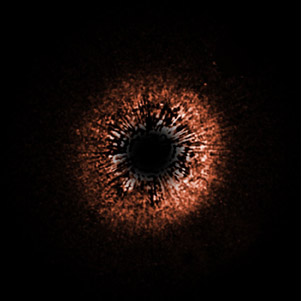A Planetary Disk
 | This debris disc imaged by the Hubble Space Telescope surrounds the sun-like star called HD 107146, located 88 light-years away from Earth (image release Dec 9, 2004). This star is judged to be a yellow dwarf star similar to the Sun, though much younger (between 30 and 250 million years old). |
Two of NASA's Observatories, the Spitzer Space Telescope and the Hubble Space Telescope, have provided images of dusty planetary debris around stars the size of our sun. Spitzer has discovered for the first time dusty discs around mature, sun-like stars known to have planets. Hubble captured the most detailed image ever of a brighter disc circling a much younger sun-like star.
The image is credited to NASA, ESA, C. Beichman (JPL), D. Ardila (JHU) and J. Krist (STScI/JPL)
The detailed web reference is http://hubblesite.org/newscenter/newsdesk/archive/releases/2004/33/Solar System Illustration
Solar System Concepts
de Pater and Lissauer
Chap 12
| HyperPhysics********** Astrophysics | R Nave |